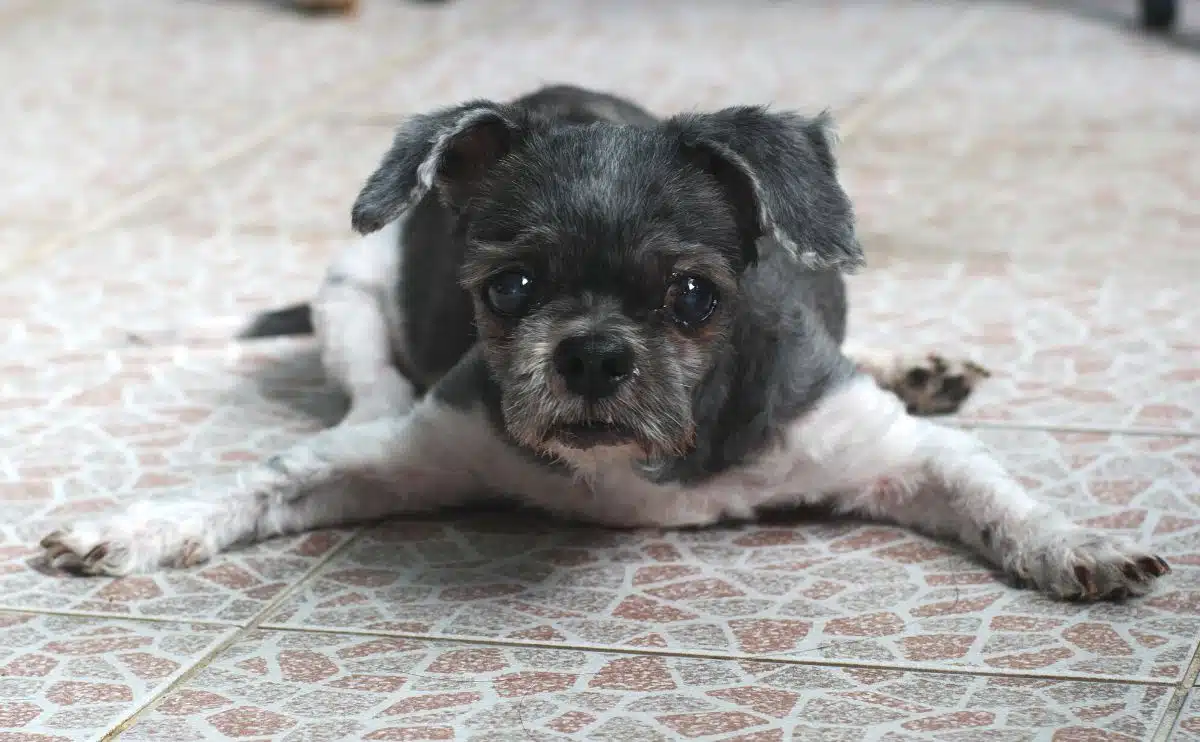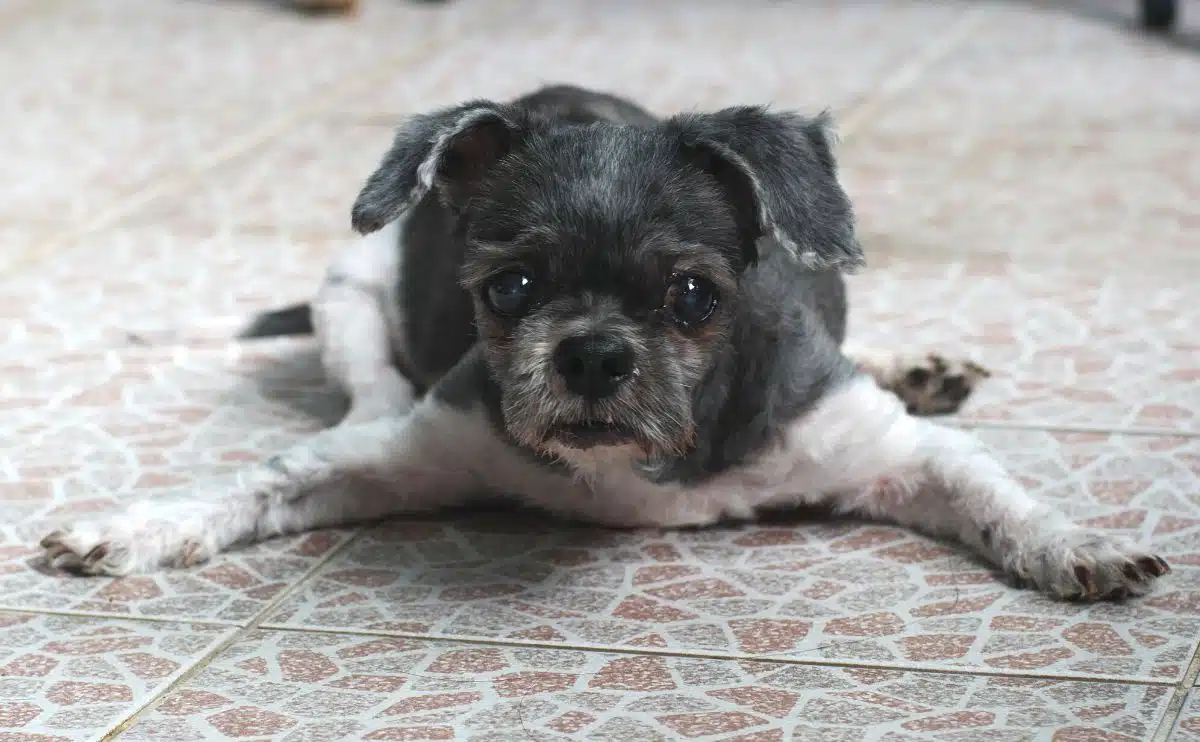
To keep the lights on, we receive affiliate commissions via some of our links. Our review process.
Is the flooring in your home like a built-in slip ‘n slide for your poor pup? Dogs slide around on slick floors for many reasons. Sometimes, all it takes is a quick fix to improve your pup’s traction. But some conditions, like old age, arthritis, leg injuries, or other health issues, cause dogs to slip on floors frequently. We’ll give you tips on how to identify the root cause of your furry friend’s instability. We also have several inexpensive solutions to help your pup get a good grip.
At A Glance: Best Anti-Slip Products For Dogs
Contents
Why Is My Dog Suddenly Slipping On The Floor?

Although they’re easier to maintain than carpeting when it comes to pet accidents (and puke), hardwood, tile, and similar flat flooring aren’t always a dog’s best friend. Unfortunately, dogs’ feet just aren’t built for smooth surfaces. That’s because canines primarily use their toenails (with their paw pads as a backup) to gain traction. Dogs can dig their nails into grass, dirt, and carpeting to get the traction they need but not with hard, flat floors.
Some conditions also predispose pups to slide on smooth floors because their muscles and joints aren’t strong enough to compensate for the lack of natural foot traction, or they’ve lost the ability to fully coordinate their mobility. Slipping on floors can be more common with older dogs and conditions such as:
Ways To Prevent Your Dog From Sliding On The Floor
Dogs sliding on floors can be hazardous, especially for pups with existing injuries, joint or spinal problems, and other mobility issues. Even for healthy pups, slipping can result in sprains and torn ligaments. So, prevention is important for your fuzzy friend’s health. Here are several ways you can help solve the slipping problem.
1. Maintain Your Dog’s Nails
One of the most common reasons for dogs sliding around on floors is, fortunately, a simple fix. Long nails can prevent your dog from gaining traction with her pads on flat flooring. So, keeping your pup’s nails trimmed regularly can be a huge help. Tip: If your dog’s toenails reach the floor, they’re too long.
We recommend the BOSHEL Dog Nail Clippers for large dogs and the gonicc Professional Pet Nail Clippers for small to medium-sized dogs. Both are easy to use and feature a safety guard to prevent over-cutting. See our step-by-step guide on how to trim your dog’s nails, including safety tips.
2. Trim Your Pup’s Toe Fur
If your dog has super furry feet, she could be sliding around because her long hair is hindering her paw pad friction. Imagine how your mobility would be compromised if you had to wear slick, fuzzy socks all the time. You can keep the hair between your pup’s pads trimmed with these Chibuy Pet Scissors, which have an easy grip and a rounded point for safety. See our tips on how to groom your dog for trimming advice.
3. Keep Paw Pads Hydrated
An extremely common but often overlooked cause is that your pup’s paw pads are too dry. Dogs can’t gain the traction they need with dry or cracked pads. So, another easy fix is to keep your pup’s pads moist and healthy with a paw balm or wax. We recommend the super-moisturizing King Kanine’s Dog Paw Balm with CBD or the all-natural Musher’s Secret Dog Paw Wax, which also helps protect your furry friend’s pads from winter elements and hot pavements.
4. Apply Adhesive Anti-Slip Dog Paw Pads
If grooming your dog’s nails, fur, and pads still doesn’t solve the problem, you can try dog paw grips for hardwood floors. These pads adhere directly to your fuzzy friend’s paw pads and have anti-slip traction to help your dog grip tile, vinyl, or wood flooring.
We recommend the durable Aqumax Dog Anti-Slip Paw Grips, which feature strong adhesive and non-slip silicone points on each paw pad for ultimate traction. They come in six sizes and are made of eco-friendly material. Many pup parents say they’re quite effective and don’t fall off easily.
5. Get Some Grippy Socks For Dogs
Anti-slip dog socks also work well for some pups, and you can remove them much easier than adhesive pads for your dog’s comfort. There are a lot of choices on the market, but based on many positive customer reviews, we think these EXPAWLORER dog socks are worth considering. They feature breathable knit fabric, large, double-sided non-skid areas, and an adjustable velcro belt to keep the socks on your pup’s feet. They come in five sizes and more than a dozen fun colors and patterns.
6. Use Dog Nail Grips
Created by a veterinarian and a mechanical engineer, Dr. McHenry’s Dog Toe Treads are designed to fit onto the two middle weight-bearing toenails to provide traction and better stability for older dogs and those suffering from mobility problems. These rubber grips come in four sizes and are easy to glue onto your pup’s nails. Each kit includes 24 grips, special glue, and a removal/cleaning brush. Many users say they’re the only anti-slip product that works for their pup, but some find them not effective or say they fall off within a few days.
7. Put Anti-Slip Tape On Stairs
You may want to consider putting some clear non-slip flooring tape on stairs and other areas where your pup slides frequently. This Trazon anti-slip clear tape is a great choice. It’s waterproof, so you can also use it outdoors on a deck and in front of your dog’s water and food bowls.
8. Add Area Rugs
Placing area rugs in strategic locations around your house can also help minimize your pup’s sliding risk. Some ideal locations could include where she jumps off your couch or bed, beneath windows if she likes standing on her hind legs to get an outdoor view, and in front of food and water bowls. For pups who have trouble standing up on smooth floors, you should also place rugs where they lie down frequently.
9. Improve Your Pup’s Joint Health
If you have a senior dog slipping on the floor, arthritis could be the culprit. Or perhaps your pup suffers from hip dysplasia or other joint problems. Giving dogs with these conditions a daily joint supplement can not only help slow disease progression, but it can also help strengthen your pup’s joints and cartilage and improve mobility.
10. Consult Your Veterinarian
If you’ve noticed other signs of instability or have tried everything in this guide and your dog is still slipping on your floors, you should consult your veterinarian. She could have an underlying condition, like those we mentioned above, that’s causing orthopedic or neurological problems.
When Your Dog Needs Extra Mobility Assistance
Older dogs and those with debilitating health conditions often require special gear to help them get around while maintaining as much independence as possible. Ways you can improve your pup’s mobility include setting up a dog ramp for your bed or sofa (and even for your car), assisting your pup using a sling lift, and getting your furry friend a doggie wheelchair. Pups with joint issues can also benefit from an orthopedic dog bed to help them sleep much more comfortably.
Tagged With: